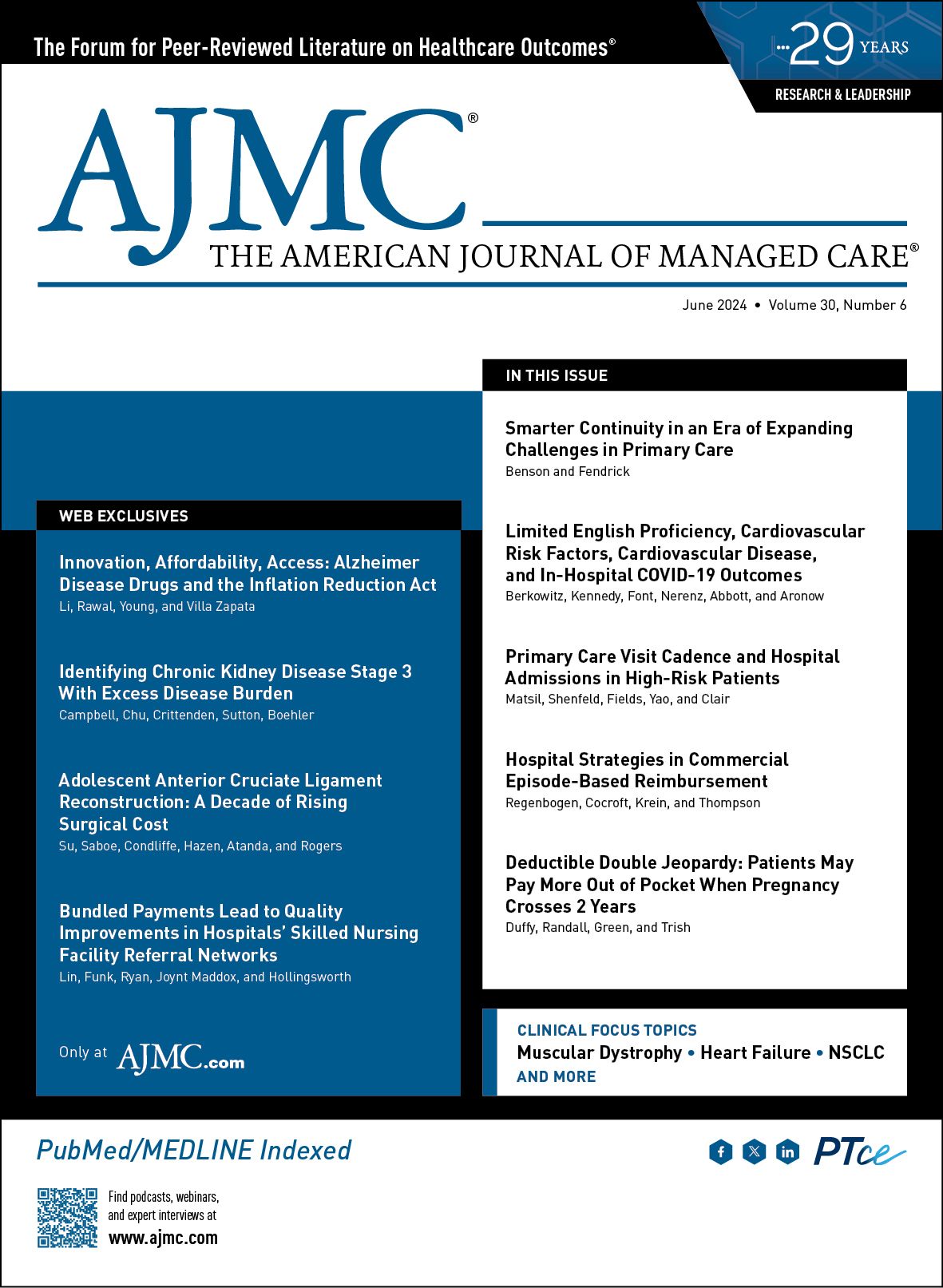Publication
Article
The American Journal of Managed Care
Innovation, Affordability, Access: Alzheimer Disease Drugs and the Inflation Reduction Act
Author(s):
The authors explore the economic impact and accessibility challenges of new Alzheimer disease drugs under the Inflation Reduction Act, with emphasis on Medicare, pricing, and health care equity.
ABSTRACT
Objectives: This analysis examines the implications of new Alzheimer disease drugs in the era of the Inflation Reduction Act (IRA). It focuses on balancing innovation in Alzheimer disease treatment with affordability and access, assessing the impact on Medicare’s budget, patient cost, and health care system readiness.
Study Design: A comprehensive review was conducted, synthesizing information from recent FDA drug approvals, drug pricing models, Medicare coverage policies, and the updated regulations under the IRA. This analysis reflects on the broader clinical and economic consequences of introducing new Alzheimer disease treatments.
Methods: The study employs a qualitative review of existing literature, policy documents, and economic data. It explores the implications of Alzheimer disease drugs on health care policy, analyzing the economic and clinical impacts within the current health care landscape in the US.
Results: The study highlights the economic challenges posed by the high costs of new Alzheimer disease drugs, contrasting with their moderate clinical benefits and potential risks. It discusses the limitations of the IRA in regulating drug prices and the resulting implications for Medicare’s budget. Additionally, it examines disparities in health care access and system preparedness for these new treatments.
Conclusions: The study findings underscore the need for a comprehensive approach to ensure fair pricing and equitable access to Alzheimer disease treatments. It suggests the application of frameworks such as the ISPOR Value Flower, focusing on diversity, equity, and comprehensive economic evaluations, to navigate the evolving landscape of Alzheimer disease treatment in the context of the IRA.
Am J Manag Care. 2024;30(6):e169-e171. https://doi.org/10.37765/ajmc.2024.89563
Alzheimer disease (AD) affects 6 million Americans and 11 million caregivers.1 The disease’s cause is attributed to amyloid β plaques in the brain.2 Recent treatment strategies include antiamyloid therapies such as Biogen’s aducanumab-avwa (Aduhelm), approved by the FDA in 2021 with a controversial $56,000 annual cost,3 later reduced to $28,000. However, this price still exceeds cost-effectiveness recommendations of $2950 to $5960.4 Notably, Biogen has announced it will discontinue Aduhelm for AD treatment starting in 2024 due to various factors, including market uptake and regulatory developments. Eisai’s lecanemab-irmb (Leqembi), priced at $26,500 annually,5 was approved in 2023, with cost-effectiveness recommendations ranging from $8900 to $21,500.6 Eli Lilly’s donanemab is another candidate awaiting approval,7 although its approval has been delayed again, reflecting ongoing regulatory reviews. CMS has expanded coverage for lecanemab, requiring data collection on its real-world benefits and risks.8
Current discussions focus on these drugs’ moderate benefits vs uncertainties regarding adverse events.6,9 The most common adverse effect is amyloid-related imaging abnormalities (ARIAs), involving brain swelling or bleeding, which necessitate regular MRI monitoring.9 ARIA risk is especially high in patients with the APOE-ε4 gene; therefore, the FDA recommends genetic testing, although insurance coverage for these tests is limited.9 Additional concerns are the efficacy and safety of these drugs in diverse populations, as most clinical trial participants have been non-Hispanic White.10,11
The introduction of these treatments aligns with changes in Medicare policies, such as the Inflation Reduction Act of 2022 (IRA), which may reduce drug costs for older adults.12 This shift is crucial in a landscape marked by high drug prices. Evaluating these new therapies within the IRA framework involves examining their budget impact on Medicare, exploring fair pricing opportunities, and assessing health system readiness for patient access. To tackle challenges in affordability, access, and safety, ISPOR’s Value Flower framework provides a comprehensive guide for future policy and health care discussions.
The IRA significantly influences Medicare’s budget, particularly concerning new AD drug coverage. Initially targeting 10 medications, its implications extend to novel AD treatments such as aducanumab and lecanemab.13,14 These drugs, which require regular administration, are set to be covered under Medicare Part B.15 A projection suggests that if a quarter of Medicare beneficiaries on AD medication were prescribed aducanumab, annual Medicare expenses for this drug alone might surpass $29 billion, making it one of the costliest items under Medicare Part B or Part D.15
Medicare’s reimbursement model for Part B drugs involves paying 106% of the average sales price (ASP) or, for new drugs without an ASP such as aducanumab and lecanemab, 103% of the wholesale acquisition cost.15 However, the IRA’s drug pricing negotiation process does not apply to biologics approved by the FDA within the past 13 years.9 Consequently, these new AD drugs are not subject to price negotiations under the IRA, leading to sustained high expenses for Medicare.
This situation raises concerns about the increasing financial burden on Medicare. Higher spending on AD drugs is likely to result in elevated Part B premiums. For instance, in anticipation of aducanumab’s inclusion, CMS announced a significant premium increase for 2022. Although the uptake of aducanumab was lower than expected, leading to a slight adjustment in premiums, the ongoing introduction of costly drugs such as lecanemab could further influence premiums.
The financial implications extend beyond Medicare’s budget. For beneficiaries, particularly those with lower incomes or minority patients who are disproportionately affected by AD, the higher costs of treatment pose a significant challenge.16,17 Under current policies, beneficiaries are responsible for paying 20% of Part B services after meeting their deductible. This cost-sharing mechanism, coupled with additional expenses related to AD treatment such as PET scans, MRIs, and APOE-ε4 gene testing, not only escalates the financial burden but also raises concerns about equitable access to these new therapies.18
Moreover, the varied demographic distribution of Medicare beneficiaries—with Black and Hispanic individuals often having lower median incomes—underscores the potential for health disparities in accessing these new AD drugs. The financial strain of high treatment costs and associated medical expenses could disproportionately affect these communities, exacerbating existing inequities in health care access and outcomes.
Opportunities for Fair Pricing Under the IRA
The IRA aims to reconcile the need for affordable drug pricing with incentives for pharmaceutical innovation. A critical challenge within this framework is the determination of a “fair price,” particularly for new AD drugs such as lecanemab, which is currently exempt from IRA price negotiations.19 This exemption raises significant concerns about their affordability and potential financial impact on Medicare. Therefore, initiating discussions about fair pricing for these drugs is essential.
Globally, cost-effectiveness analysis is a prevalent approach for evaluating drug value and balancing health benefits against costs. This method could be instrumental in assessing whether treatments such as lecanemab, priced at $26,500 per year, offer health benefits that justify their cost. However, the IRA’s specific prohibition against using quality-adjusted life-years (QALYs) in pricing negotiations, due to concerns about discrimination against patients with long-term illnesses or disabilities, necessitates alternative metrics.20
Metrics such as the equal value of life-years gained, health years in total, and the generalized risk-adjusted QALY (GRA-QALY) offer viable substitutes. These alternatives, especially GRA-QALY, are more inclusive and align with Congress’ intention for unbiased, value-based medication assessments within Medicare. Adopting these metrics could provide a more equitable approach to drug pricing, ensuring that the IRA’s objectives are met in a manner that balances affordability with the need for medical innovation.21
More Than Pricing: Is the US Health Care System Ready for the New AD Drugs?
Beyond pricing, the question remains whether the US health care system is prepared for the introduction of new AD drugs. For effective use of these medications, patients require specialist assessment and diagnostic testing. However, the US faces a significant shortage of neurologists, especially in 20 states identified as “neurologist deserts” with fewer than 10 specialists per 10,000 patients with AD.22 This scarcity leads to long waiting times, with a simulation suggesting an average 18.6-month wait for treatment due to limited specialist availability and restricted access to necessary diagnostic tests and facilities such as PET scans and infusion centers.23 The US has fewer AD specialists per capita compared with countries such as Germany and Italy, raising concerns about an impending care crisis.18
Antiamyloid drugs target patients in early stages of AD, but structural barriers might prevent timely access for some, especially in communities with predominant minority populations. Disparities are also evident in the location of neuroimaging centers, which are usually situated in affluent, White neighborhoods, further limiting access for minority groups. This situation underscores the need to enhance the health care infrastructure and ensure equitable access to diagnostic and treatment facilities across diverse communities, thereby ensuring all eligible patients can benefit from these new AD therapies.
Proposal for the Future
In addressing the challenges presented by new AD drugs, we propose adopting the ISPOR Value Flower framework in the IRA era.14 This approach emphasizes diversity, equity, comprehensive economic evaluation, and stakeholder engagement.
Diversity and Equity
- Diversity in clinical trials: It is crucial that clinical trials for AD drugs mirror the diversity of the patient population. This includes actively recruiting from underrepresented communities to ensure safety and efficacy data are relevant for all racial and ethnic groups.
- Diversity in real-world evidence: Real-world evidence studies should encompass diverse patient populations, taking into consideration race, ethnicity, socioeconomic status, and geography. This broadens understanding of how treatments function across various contexts.
- Equity in access: Coverage policies need to be developed with equity in mind, prioritizing equitable access to AD treatments for all, regardless of race, income, or geography.
Holistic Economic Evaluations
These evaluations should extend beyond immediate drug costs to consider long-term health care savings, such as reduced hospitalizations and caregiving needs. Policy makers must prioritize treatments offering significant long-term benefits while maintaining cost-effectiveness. Transparent price negotiations and value-driven decisions are key to balancing care quality with financial sustainability.
Stakeholder Engagement
- Engaging patients and caregivers is essential for understanding the real-world impact of treatments. This includes evaluating benefits vs adverse events and aligning coverage policies with patient needs and preferences.
- Health care professionals specializing in AD care provide valuable insights into treatment administration, adverse event management, and overall patient care.
- Discussions with pharmaceutical manufacturers about pricing strategies are vital to promote affordability and access.
The ISPOR Value Flower framework’s comprehensive approach is pivotal for navigating the landscape of AD treatment in the IRA era. The approval of new antiamyloid drugs has raised concerns regarding their significant costs and potential adverse events, as well as questions about the US health care system’s readiness to administer these treatments. Emphasizing diverse and equitable clinical trials, holistic economic evaluations, and robust stakeholder engagement aims to optimize AD treatment outcomes, ensuring optimal care for patients within a sustainable economic framework.
Author Affiliations: Department of Clinical and Administrative Pharmacy, University of Georgia College of Pharmacy (NL, SR, HNY, LVZ), Athens, GA.
Source of Funding: No source of funding reported.
Author Disclosures: The authors report no relationship or financial interest with any entity that would pose a conflict of interest with the subject matter of this article.
Authorship Information: Concept and design (NL, SR,LVZ); drafting of the manuscript (NL, SR, HNY, LVZ); critical revision of the manuscript for important intellectual content (NL, SR, HNY, LVZ); administrative, technical, or logistic support (NL); and supervision (LVZ).
Address Correspondence to: Lorenzo Villa Zapata, PhD, Department of Clinical and Administrative Pharmacy, University of Georgia College of Pharmacy, 250 W Green St, RC Wilson Pharmacy, 260H, Athens, GA 30602. Email: Lorenzo.villazapata@uga.edu.
REFERENCES
1. Alzheimer’s disease fact sheet. National Institute on Aging. Updated April 5, 2023. Accessed October 14, 2023. https://www.nia.nih.gov/health/alzheimers-disease-fact-sheet
2. Beta-amyloid and the amyloid hypothesis. Alzheimer’s Association. Updated March 2017. Accessed October 14, 2023. https://www.alz.org/documents/national/topicsheet_betaamyloid.pdf
3. FDA approves Aduhelm, first new drug for Alzheimer’s in 20 years, despite questions. CBS News. June 7, 2021. Accessed October 14, 2023. https://www.cbsnews.com/news/fda-alzheimers-drug-approval-biogen-aduhelm/
4. Whittington MD, Campbell JD, Rind D, Fluetsch N, Lin GA, Pearson SD. Cost-effectiveness and value-based pricing of aducanumab for patients with early Alzheimer disease. Neurology. 2022;98(9):e968-e977. doi:10.1212/WNL.0000000000013314
5. FDA converts novel Alzheimer’s disease treatment to traditional approval. News release. FDA. July 6, 2023. Accessed October 14, 2023. https://www.fda.gov/news-events/press-announcements/fda-converts-novel-alzheimers-disease-treatment-traditional-approval
6. Lin G, Whittington M, Wright A, et al. Lecanemab for Early Alzheimer’s Disease: Final Evidence Report. Institute for Clinical and Economic Review. April 17, 2023. Accessed October 9, 2023. https://icer.org/wp-content/uploads/2023/04/ICER_Alzheimers-Disease_Final-Report_For-Publication_04172023.pdf
7. Constantino AK. Eli Lilly expects FDA decision on Alzheimer’s treatment donanemab by the end of the year. CNBC. July 17, 2023. Accessed October 14, 2023. https://www.cnbc.com/2023/07/17/alzheimers-eli-lilly-expects-fda-decision-on-donanemab-by-year-end.html
8. Cubanski J, Neuman T. New Alzheimer’s drugs spark hope for patients and cost concerns for Medicare. KFF. July 6, 2023. Accessed October 14, 2023. https://www.kff.org/policy-watch/new-alzheimers-drugs-spark-hope-for-patients-and-cost-concerns-for-medicare/
9. Brockmann R, Nixon J, Love BL, Yunusa I. Impacts of FDA approval and Medicare restriction on antiamyloid therapies for Alzheimer’s disease: patient outcomes, healthcare costs, and drug development. Lancet Reg Health Am. 2023;20:100467. doi:10.1016/j.lana.2023.100467
10. Manly JJ, Deters KD. Donanemab for Alzheimer disease-who benefits and who is harmed? JAMA. 2023;330(6):510-511. doi:10.1001/jama.2023.11704
11. Reardon S. Alzheimer’s drug donanemab: what promising trial means for treatments. Nature. 2023;617(7960):232-233. doi:10.1038/d41586-023-01537-5
12. Biden-Harris administration takes major step forward in lowering health care costs; announces manufacturers participating in drug price negotiation program. News release. The White House. October 3, 2023. Accessed October 22, 2023. https://www.whitehouse.gov/briefing-room/statements-releases/2023/10/03/biden-harris-administration-takes-major-step-forward-in-lowering-health-care-costs-announces-manufacturers-participating-in-drug-price-negotiation-program/
13. Fact sheet: Biden-Harris administration announces first ten drugs selected for Medicare price negotiation. News release. The White House. August 29, 2023. Accessed October 28, 2023. https://www.whitehouse.gov/briefing-room/statements-releases/2023/08/29/fact-sheet-biden-harris-administration-announces-first-ten-drugs-selected-for-medicare-price-negotiation/
14. Neumann PJ, Garrison LP, Willke RJ. The history and future of the “ISPOR Value Flower”: addressing limitations of conventional cost-effectiveness analysis. Value Health. 2022;25(4):558-565. doi:10.1016/j.jval.2022.01.010
15. Cubanski J, Neuman T. FDA’s approval of Biogen’s new Alzheimer’s drug has huge cost implications for Medicare and beneficiaries. KFF. June 10, 2021. Accessed October 14, 2023. https://www.kff.org/medicare/issue-brief/fdas-approval-of-biogens-new-alzheimers-drug-has-huge-cost-implications-for-medicare-and-beneficiaries/
16. Koma W, Neuman T, Jacobson G, Smith K. Medicare beneficiaries’ financial security before the coronavirus pandemic. KFF. April 24, 2020. Accessed October 14, 2023. https://www.kff.org/medicare/issue-brief/medicare-beneficiaries-financial-security-before-the-coronavirus-pandemic/
17. Race, ethnicity, and Alzheimer’s. Alzheimer’s Association. March 2020. Accessed October 14, 2023. https://aaic.alz.org/downloads2020/2020_Race_and_Ethnicity_Fact_Sheet.pdf
18. Allen A. The real costs of the new Alzheimer’s drug, most of which will fall to taxpayers. KFF Health News. August 2, 2023. Accessed October 14, 2023. https://kffhealthnews.org/news/article/the-real-costs-of-the-new-alzheimers-drug-most-of-which-will-fall-to-taxpayers/
19. Goldman D, Grogan J, Lakdawalla D, et al. Mitigating the Inflation Reduction Act’s adverse impacts on the prescription drug market. USC Schaeffer. April 13, 2023. Accessed October 9, 2023. https://healthpolicy.usc.edu/research/mitigating-the-inflation-reduction-acts-potential-adverse-impacts-on-the-prescription-drug-market/
20. Kim DD, Basu A. How does cost-effectiveness analysis inform health care decisions? AMA J Ethics. 2021;23(8):E639-E647. doi:10.1001/amajethics.2021.639
21. Frank RG, Nichols LM. Threats to Medicare’s new drug negotiation power. Brookings. March 15, 2023. Accessed October 26, 2023. https://www.brookings.edu/articles/threats-to-medicares-new-drug-negotiation-power/
22. Regional shortage of neurologists revealed across the U.S. News release. Alzheimer’s Association International Conference. July 16, 2017. Accessed October 14, 2023. https://aaic.alz.org/releases_2017/AAIC17-Sun-neurology-deserts.asp
23. Liu JL, Hlavka JP, Hillestad R, Mattke S. Assessing the preparedness of the U.S. health care system infrastructure for an Alzheimer’s treatment. RAND Corporation. November 15, 2017. Accessed October 14, 2023. https://www.rand.org/pubs/research_reports/RR2272.html






